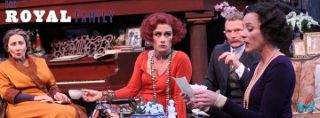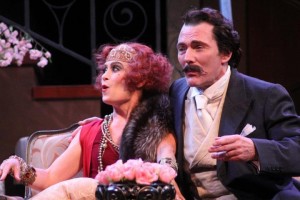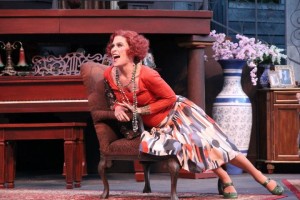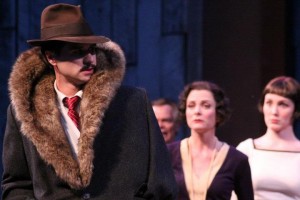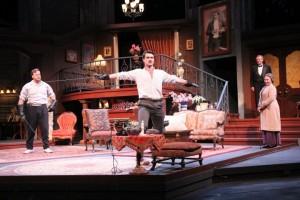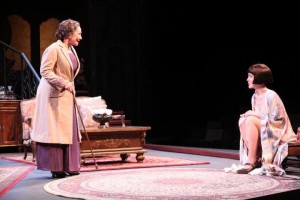THE SKY PARTS FOR THE ROYALS
There are few regional theater pleasures more delectable than attending the outdoor American Players Theatre on a balmy afternoon or evening. The theater, about three hours from Chicago, is in a natural amphitheater with both lush, bucolic foliage and a soothing background soundtrack of chirping insects. The downside of the outdoor play going experience is a nasty turn in the weather, notably rain: a downpour before Richard III forced me away from the theater and back to Illinois. The APT cancels very few performances because of rain, but judging from the rainfall I experienced on the way out of Wisconsin, Richard needed more than a horse, his kingdom for a horse, to sustain him. He needed pontoons.
Fortunately, the theater gods smiled for the very solid production of Kaufman and Ferber’s The Royal Family, a satire on the Barrymore theater clan, a dominant force in American show business during the early 1900’s. The titular Cavendish family is a thinly disguised portrait of the Barrymores: Maurice Barrymore, long deceased at the start of the play, his wife Georgiana Drew Barrymore, and their children Lionel, John, and Ethel; Drew Barrymore, a later member of the family, is the daughter of Ethel.
The Barrymores were not only the first family of the American stage in the 1920’s, they were a brood of temperamental personalities that would have been prime fodder for People Magazine a few generations later. The chief eccentric in the family was John Barrymore (who becomes the charcter of Tony Cavendish in the play), a terrific actor and an equally terrific womanizer and spendthrift with an ego as big as Broadway and beyond. The Royal Family doesn’t have a coherent plot; instead, it is a collection of incidents that displays the members of the family with all their larger-than-life flamboyance. It’s also a moving valentine to the theater and the Barrymores’ passion for the stage. For Fanny Cavendish, the matriarch of the family, the theater isn’t the best life, it’s the only life, and the threats by both Gwen and Julie to leave the stage for a normal life fill her not so much with outrage as incomprehension.
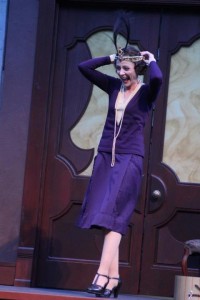 Chicagoland playgoers will recognize Tracy Michelle Arnold and Marcus Truschinski in the pivotal roles of Julie and Tony Cavendish. Truschinski has a ball with the self-dramatizing Tony, but Ms. Arnold is the heart of the play as the conflicted Julie, torn between the greasepaint in her veins and her desire to lead a life anchored by normalcy; she has fame and fortunate but at what personal sacrifice?
Chicagoland playgoers will recognize Tracy Michelle Arnold and Marcus Truschinski in the pivotal roles of Julie and Tony Cavendish. Truschinski has a ball with the self-dramatizing Tony, but Ms. Arnold is the heart of the play as the conflicted Julie, torn between the greasepaint in her veins and her desire to lead a life anchored by normalcy; she has fame and fortunate but at what personal sacrifice?
The ensemble is filled with fine supporting performances, especially from David Daniel as the Cavendish’s long-suffering manager Oscar Wolfe and Jonathan Smoots as Fanny’s brother Herbert. Herbert and his bitchy wife Kitty (a spot-on performance by Colleen Madden), are a pair of hammy actors who refuse to accept that the modern theater has passed their old-time style for good. Sarah Day is good as Fanny, though she seems a little young for the dominant woman in her early 70’s; this is an assertive role that would be grist for a powerful actress like Judi Dench or Helen Mirren.
Laura Gordon’s directing keeps the controlled frenzy of the Cavendish world funny and sometimes moving. The production hews to its late 1920’s roots in Fabio Toblini’s costumes and Nathan Stuber’s New York penthouse interior set.
The APT makes attending their productions as user friendly as possible. The staff is good-natured and knowledgeable from top to bottom. An announcement before the start apologized for the delay in starting because the shuttle bus was still transporting spectators to the theater, but the show only started six minutes late. I can’t remember the last Chicago production I attended that started less than ten minutes late and there was never an apology or explanation.
photos by Carissa Dixon
The Royal Family
American Players Theatre’s Up-the-Hill Theatre
Spring Green, Wisconsin
ends on September 29, 2012
for tickets, visit American Players
